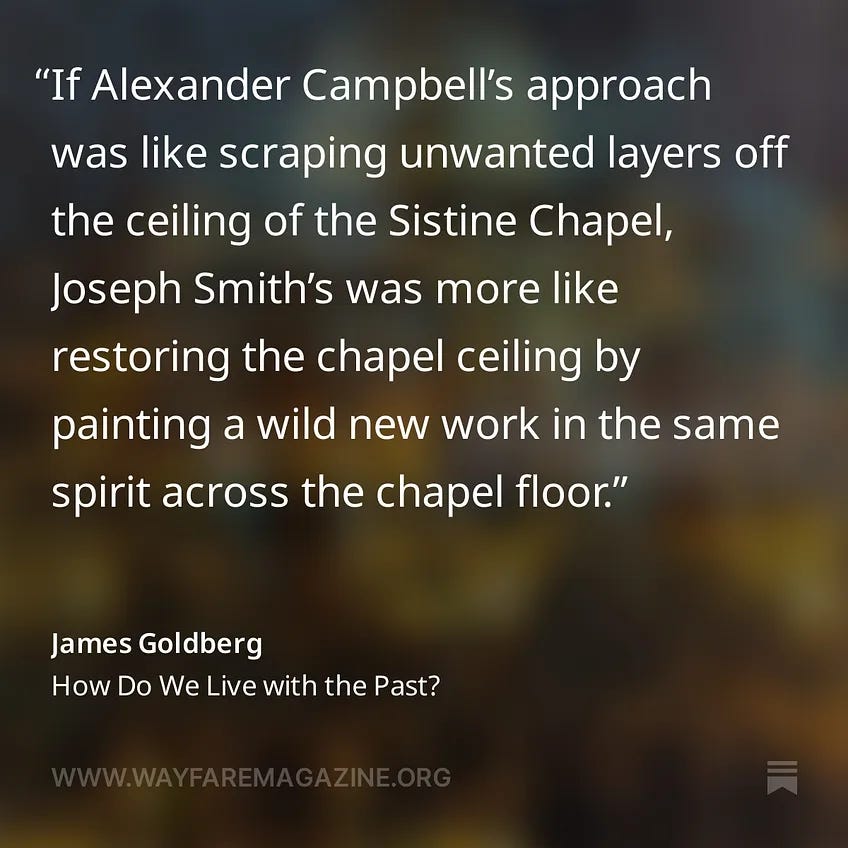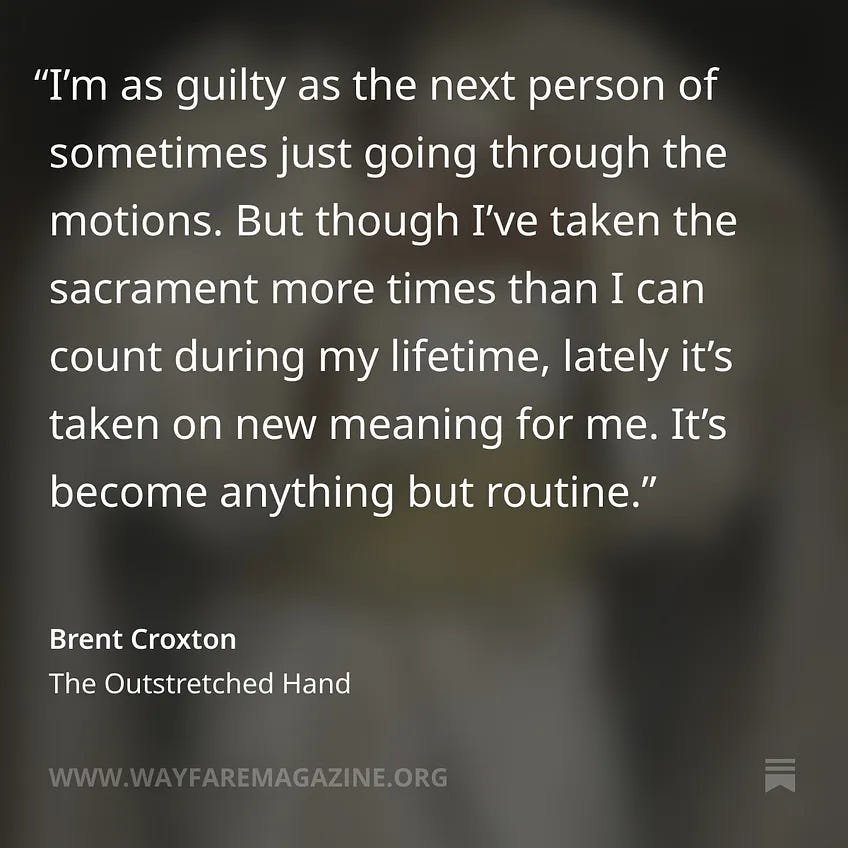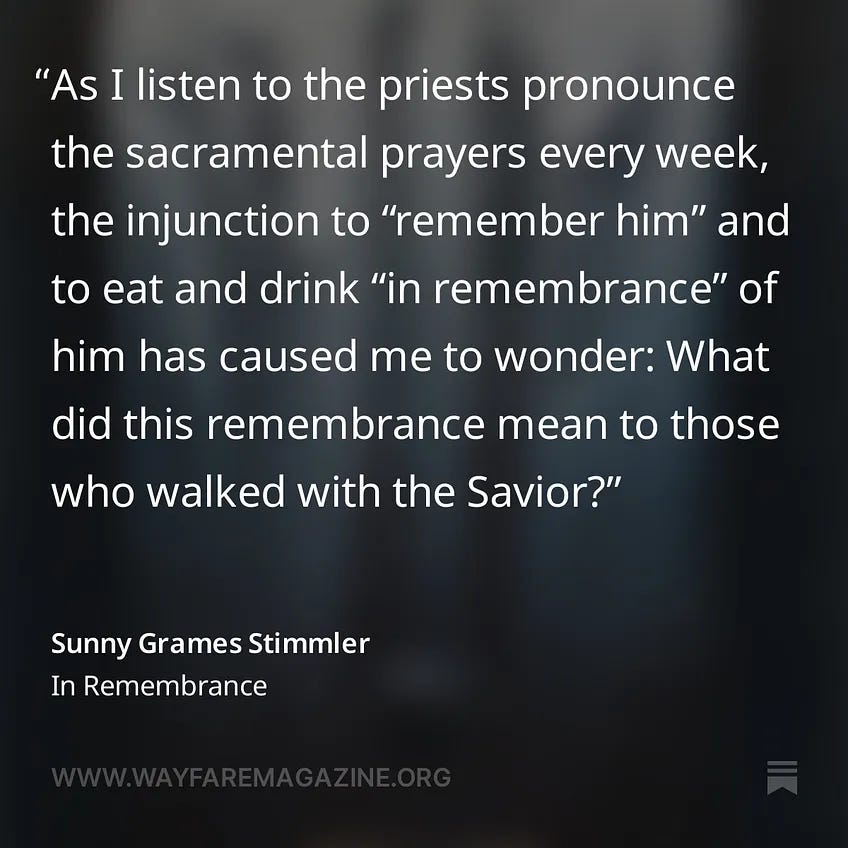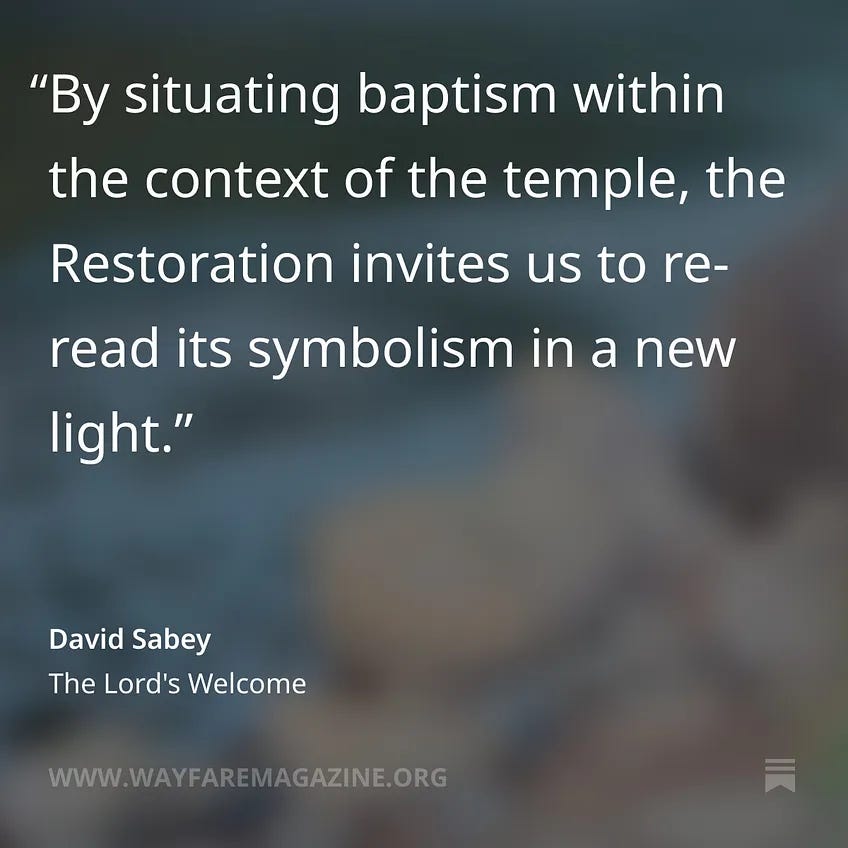Why Church?
Faith Matters resources to accompany your Come Follow Me study: March 10-16

Jesus Christ has restored His Church.
Why Church? Check out this short video from Faith Matters:
Eugene England also wrote a classic essay on this subject titled “Why the Church is as True as the Gospel.” It’s been appreciated by many thoughtful saints over the years and is well worth a read.
To think more about what “restoration” can mean, read “The Abounding Church,” a Wayfare essay from Terryl Givens:
We invite several perils by associating "restoration" and "fullness" with past and total incarnations. The words presume a fixity, a stasis, an ahistorical set of practices and principles sufficient for all times and conditions—a theological universe, in sum, that is static, sterile and ultimately, stifling. Creativity, novelty, growth, adaptation, adventure, and exuberance find little place in such a programmatic vision. Instead of a dynamic process of unfolding spiritual truths, a process that we participate in with God, connotations of the word “fullness” can suggest simply reassembling puzzle pieces already present into a bordered whole.
I see a different God in Joseph Smith’s revelations, one more similar to the God of Genesis, who says, “Let us create.”
Check out “How Do We Live with the Past?” by James Goldberg:
Watch our conversation with Patrick about his book Restoration:
Listen to “Restoring the People of God,” an excerpt from Restoration:
Yes, there are many “things” to restore. But ultimately God isn't concerned with restoring “things” as much as he is with using those things to restore what really matters—“his people.” So the “restoration of all things” is designed with one grand aim in mind: restoring God's people—our Father and Mother's children, their eternal family—to wholeness.
And read “The Restored Church or the "Restoring" Church?” and “True and Living Church: Bearer and Receiver of Gifts,” two more excerpts from Restoration.
Go even deeper with The Big Questions project to keep exploring the question, In what way is our church “the true church?”
To learn more about the early Christian church, listen to Meet the Early-Day Saints, a limited series produced and hosted by Blair Hodges for Wayfare. In Meet the Early-day Saints, Blair takes you on a journey through time to meet the earliest disciples of Jesus. You’ll learn from a wide range of esteemed Latter-day Saint scholars who reveal the similarities and differences between ancient Christian faith and ours today. Throughout the series, some of your common assumptions may be challenged and in the process you’ll gain a deeper understanding of the gospel of Jesus Christ.
In the first episode, we ask what if the “Great Apostasy” wasn’t so great after all? Latter-day Saint scholar Jason R. Combs invites us to revisit our assumptions about the Christians who came before us as we discuss his chapter “Understanding Ancient Christians, Apostasy, and Restoration,” from the book Ancient Christians: An Introduction for Latter-day Saints.
Sacred ordinances help me become like the Savior.
If you’re looking for a roadmap for how to engage with “the works” of the religious life in ways that bring meaning, rather than a feeling of just going through the motions, check out Gracing, by Hannah Packard Crowther. You can read an excerpt on this topic in Wayfare:
It’s not just separate and distinct agreements made at baptism, during the sacrament, and in the temple. It’s not a legal contract with pages of clauses. It’s one promise. It’s one choice. It’s saying yes to gracing. Fundamentally, it’s not making covenants (plural), it’s living in covenant (singular). It’s living in Christ.
…Life is busy, no doubt. And it can easily become a long list of empty nothings if we constantly find ourselves checked out or oblivious to our divine partner. We may think we’re on our way to heaven as we do all the right things, but in this frame of mind, we could arrive in heaven and not even know it. All these works, even if performed exactly and by the book, will be hollow. They will fail to transform us. They won’t help us fly.
Going deeper, we can repurpose our tools. Learning to bring God’s music into our activities often requires practice. Our intention shifts. We say yes to God. We invite God into the process, even if the end result is unknowable or undefined. It’s characterized by hope and seeking. It has a wholly and holy different feel.
Priesthood service blesses Church members and their families.
In the Greco-Roman world of early Christianity, women were considered inferior to men. Dr. Ariel Bybee Laughton says Christianity offered new ways to think about the roles of women in society, and that their power and authority waxed and waned over time. Listen to her discussion with Blair Hodges on her chapter “Church Organization: Priesthood Office and Women’s Leadership Roles” from the book Ancient Christians: An Introduction for Latter-day Saints in the Wayfare podcast Meet the Early-Day Saints:
Listen to (or read a transcript of) our conversation with Barbara Morgan Gardner on The Priesthood Power of Women.
And for more on the role of women in the LDS Church, listen to “The Future of Women at Church: A Conversation with Neylan McBaine” and “What's the Future of Women at Church? - A Conversation with Neylan McBaine and Bethany Brady Spalding,” and read “Women at Church: 10 Years Later” by Neylan McBaine.
Obeying God’s word through His prophets will give me divine protection.
Read “Searching for Infallible Prophets?” by Patrick Mason:
I’m only secondarily interested in God’s prophets and apostles. To focus on them is to miss the point. Doing so is like a person wearing glasses training their gaze on their lenses rather than looking through them at the world beyond. Latter-day Saint prophets and apostles serve as corrective lenses in a secular age, but they don’t offer a perfect prescription. In this life we will always “see in a mirror, dimly.” Even living prophets, themselves trapped on this side of the veil, cannot provide perfect clarity or get us to 20/20 vision. The lenses themselves get smudged, chipped, and cracked from the wear and tear of the world. But the collective experience of the Church of Jesus Christ of Latter-day Saints is strong testimony that looking through this particular set of lenses is a reliable means of focusing our gaze on how to follow the Savior Jesus Christ in the modern world.
In short, the church can confidently rely on its living prophets—not blindly, but with discernment, individual choice, and always with the “patience and faith” that God’s redemptive work in the world is bigger than we can often see. We sustain the prophets not because of their own merits but insofar and inasmuch as they preach “the word of Christ with unshaken faith in him, relying wholly upon the merits of him who is mighty to save.” (2 Nephi 31:19; see also Moroni 6:4.)
Latter-day Saints are not Smithites, or Nelsonites, or even Mormonites. We are Christians. We look not to our prophets but with them to “Jesus the author and finisher of our faith.”
Go even deeper with The Big Questions Project: In the past, church leaders have made some significant mistakes. How much should I rely on pronouncements and teachings of our leaders today?
When I am baptized and confirmed, I promise to follow Jesus Christ.
Read Hannah Packard Crowther’s thoughts on baptism in Gracing:
Consider baptism, one of the many works we do. I was baptized by my dad when I was eight years old. I have a photo of my baptism day, standing in front of the stake center with my family. With the summer sun in my face, I am smiling and squinting. I don’t remember much about that day. I remember a boy in my Primary class also got baptized. And I remember the water was warm. I assume that I was pleased to be making that big step. I made a choice I didn’t remotely understand. But I did it gladly.
Afterwards, I learned more about what this decision meant. I went to Primary and Young Women’s. I learned about the temple and the promises we make there and how everyone would have the chance to be baptized in either this life or the next. I tried to choose the right and sometimes chose wrong. The sacrament was a way to renew the covenants I had made at baptism. These covenants, I learned, were like a two-way contract between us and God. We made promises, and God reciprocated. We lived good lives, and God would eventually welcome us home.
Many years later, though, questions arose. What was it about baptism that made some people fit for heaven and others not? Why require such a seemingly arbitrary entrance requirement for heaven? Sure, there is deep symbolism built into baptism, but wasn’t it still just symbolism? It seemed that when all was said and done, God would be less interested in the symbol and more interested in the real thing—the transformed heart.
While these questions simmered, I heard a Jewish rabbi speak, and something became clear. While this rabbi was only tangentially speaking about covenants, he reframed them for me. He said that he was sometimes asked by people who were not Jewish, “What makes you so special?” The implication was, “What gives you the arrogance to call yourselves a chosen people?” Latter-day Saints could ask themselves this same question: among the billions of people who have lived on earth, why would God give this unique piece of saving information to just a few favorites? Who made us the teacher’s pet?
The rabbi’s response to this question was simple: God chooses those who choose Him.
This felt like a mic drop moment. It was so basic. Could it be that this was the essence of covenant? Fundamentally, it’s not about reciprocal duties, but rather, reciprocal relationship?
And could it be that at the heart of every covenant we make is this one same truth? It’s not just separate and distinct agreements made at baptism, during the sacrament, and in the temple. It’s not a legal contract with pages of clauses. It’s one promise. It’s one choice. It’s saying yes to gracing. Fundamentally, it’s not making covenants (plural), it’s living in covenant (singular). It’s living in Christ.
Baptism is not fundamentally about keeping some people out of heaven and letting others in. The symbol is an invitation. Baptism says, “Salvation is here.” Right now. Enter God’s presence and start living life as it was meant to be lived. Baptism says, “In Christ, your old self has died and your new one has risen.” Don’t wait. Enter into the divine dance now, so that when you mourn with those who mourn, and comfort those who stand in need of comfort, you will do these things differently. You will do them in Christ.







